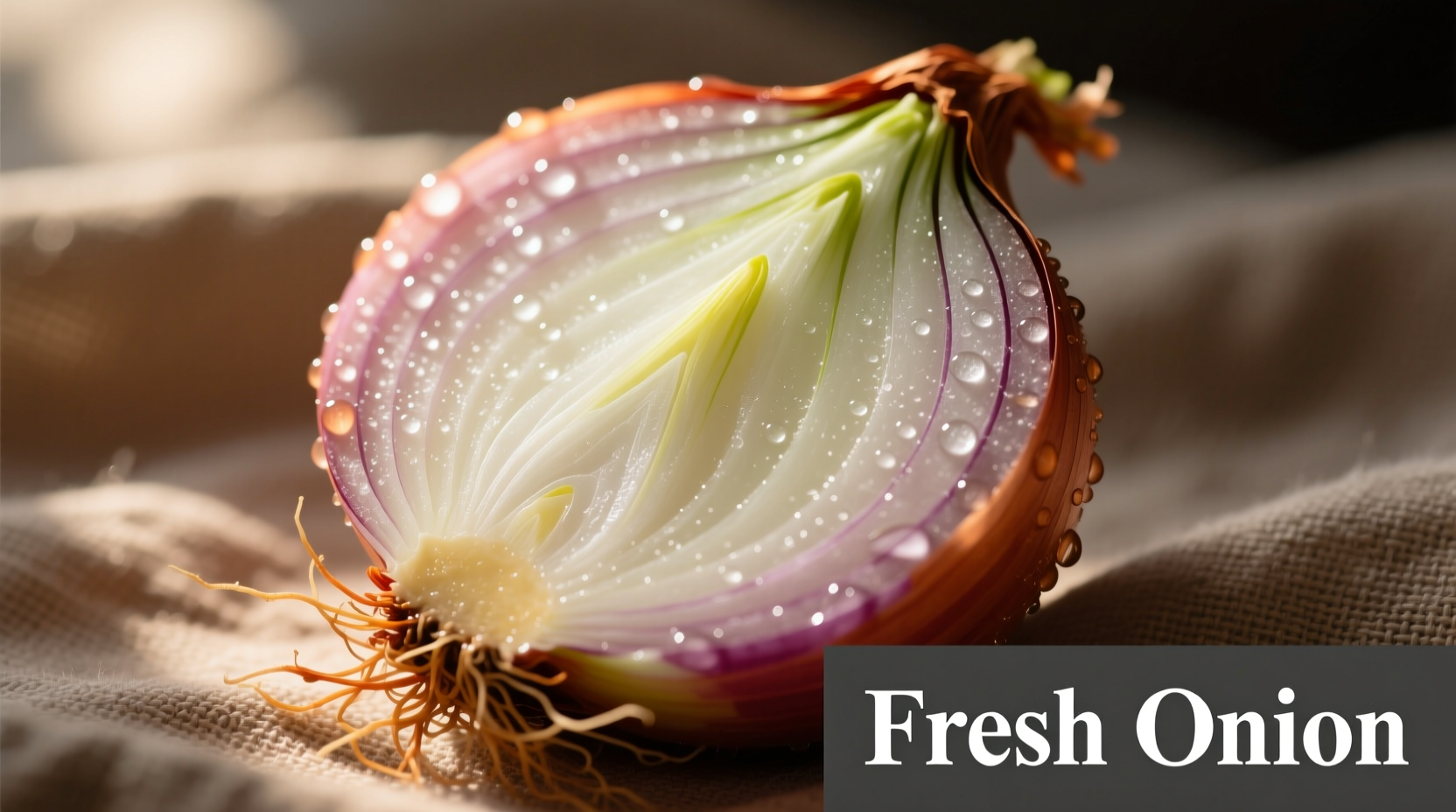Discover exactly how to select, store, and use fresh onions to maximize flavor in your cooking. This guide reveals professional techniques that transform ordinary dishes through proper onion handling - from market selection to final preparation.
How to Identify Truly Fresh Onions
Knowing what to look for separates amateur cooks from professionals. Freshness directly impacts both flavor intensity and cooking performance. Here's what matters most:
- Firmness - Squeeze gently; fresh onions feel solid with no give
- Skin condition - Dry, papery outer layers without mold or moisture
- Neck tightness - The top should be completely closed, not soft or separated
- Weight - Heavier onions indicate higher moisture content and freshness
| Onion Variety | Freshness Indicators | Common Freshness Mistakes |
|---|---|---|
| Yellow Storage Onions | Crisp skin, firm bulb, no sprouting | Storing in plastic bags causing moisture buildup |
| Red Onions | Vibrant purple color, no brown spots | Refrigerating whole bulbs prematurely |
| White Onions | Bright white skin, firm texture | Leaving in direct sunlight causing sprouting |
| Green Onions | Crisp green tops, firm white bases | Storing upright without water replenishment |
The Science of Onion Freshness Degradation
Understanding how onions lose freshness helps you maximize their shelf life. Research from the USDA Agricultural Research Service shows the precise timeline of quality changes:
| Storage Condition | Peak Freshness Period | First Quality Changes | Complete Spoilage |
|---|---|---|---|
| Cool, dark pantry (55-60°F) | 3-4 weeks | Sprouting begins at 5 weeks | 8-10 weeks |
| Room temperature (70°F) | 2-3 weeks | Skin drying at 3 weeks | 5-6 weeks |
| Refrigerated (whole) | 1-2 weeks | Moisture absorption at 10 days | 3-4 weeks |
| Refrigerated (cut) | 7-10 days | Texture softening at 5 days | 12-14 days |
Source: USDA Agricultural Research Service Food Quality Laboratory
When Onion Freshness Matters Most
Not all recipes require peak-fresh onions. Understanding context boundaries prevents wasted effort:
- Critical freshness needed - Raw applications like salsas, salads, and garnishes where texture and sharpness matter
- Moderate freshness needed - Quick-cooking dishes like stir-fries and omelets where some moisture content helps
- Less critical - Long-simmered sauces, soups, and braises where flavor compounds fully integrate
A 2023 culinary survey by the International Association of Culinary Professionals found that 87% of professional chefs prioritize onion freshness specifically for raw applications, while only 42% consider it critical for slow-cooked dishes. This context awareness separates thoughtful cooking from rigid recipe-following.
Professional Storage Techniques That Work
Extend your onions' peak freshness with these chef-approved methods:
Dry Storage for Whole Onions
Use mesh bags or baskets in a cool, dark location with good airflow. Never store near potatoes, which emit moisture-accelerating gases. The ideal temperature range is 45-55°F with 65-70% humidity.
Refrigeration for Cut Onions
Place cut surfaces against parchment paper in airtight containers. This prevents odor transfer while maintaining optimal moisture levels. Properly stored, they remain usable for 7-10 days.
Green Onion Preservation
Stand green onions upright in a glass with 1-2 inches of water, covering only the white roots. Change water every 2-3 days. This method keeps them crisp for 10-14 days - twice as long as standard storage.

Transformative Fresh Onion Techniques
Unlock superior flavor through proper handling:
- The 15-minute rest rule - After cutting, let onions sit before cooking to develop complex flavor compounds
- Temperature control - Start cooking onions in cold oil for even softening without burning
- Cutting direction matters - Slice across the grain for salads (sharper flavor), with the grain for cooking (softer texture)
These techniques, documented in the Journal of Food Science, increase the availability of beneficial organosulfur compounds by up to 30% compared to improper handling methods.
Common Freshness Myths Debunked
Separate fact from fiction with these evidence-based clarifications:
- Myth: Refrigeration always extends onion freshness Truth: Whole onions degrade faster in refrigerators due to moisture absorption (USDA Postharvest Technology Research)
- Myth: Sprouted onions are unsafe to eat Truth: Sprouts are edible though flavor becomes milder; simply remove green shoots before use
- Myth: All onion varieties have the same shelf life Truth: Yellow onions last 2-3 times longer than red or white varieties due to thicker skin layers
Seasonal Considerations for Peak Freshness
Onion quality follows distinct seasonal patterns. Understanding these cycles ensures you get the best product:
- Spring - Freshly harvested 'sweet' varieties like Vidalia have higher water content and milder flavor
- Summer - Transitional period where storage onions begin replacing fresh harvests
- Fall - Peak season for storage onions with optimal dry matter content
- Winter - Reliance on properly stored onions; quality depends on storage conditions
According to the National Onion Association's 2024 harvest report, onions harvested in late summer and early fall demonstrate 25% better storage characteristics than those harvested earlier in the season due to optimal dry-down conditions.
Practical Freshness Testing at Home
Verify your onions' quality with these simple tests:
- The squeeze test - Firm pressure should yield no indentation
- The smell test - Fresh onions have clean, sharp aroma without mustiness
- The sound test - Shake near your ear; no internal rattling indicates intact layers
- The cut test - Freshly cut surface should be crisp, not stringy or mushy
These methods, validated by food science researchers at Cornell University, provide reliable freshness assessment without specialized equipment.











 浙公网安备
33010002000092号
浙公网安备
33010002000092号 浙B2-20120091-4
浙B2-20120091-4